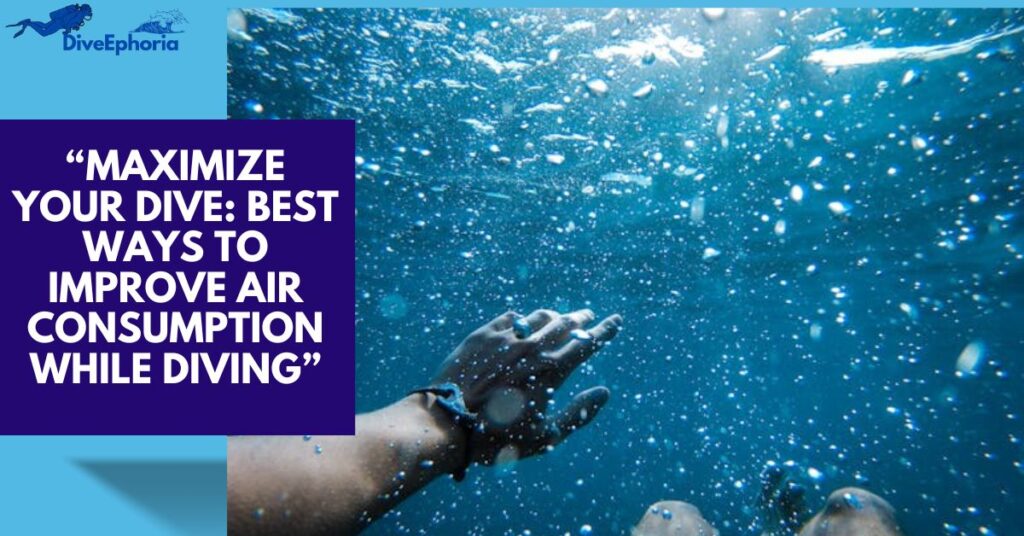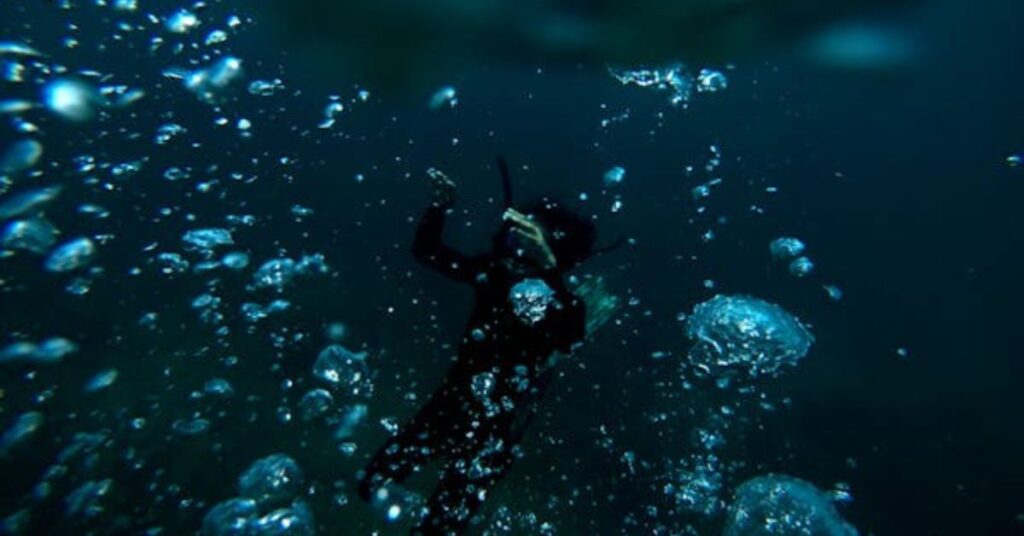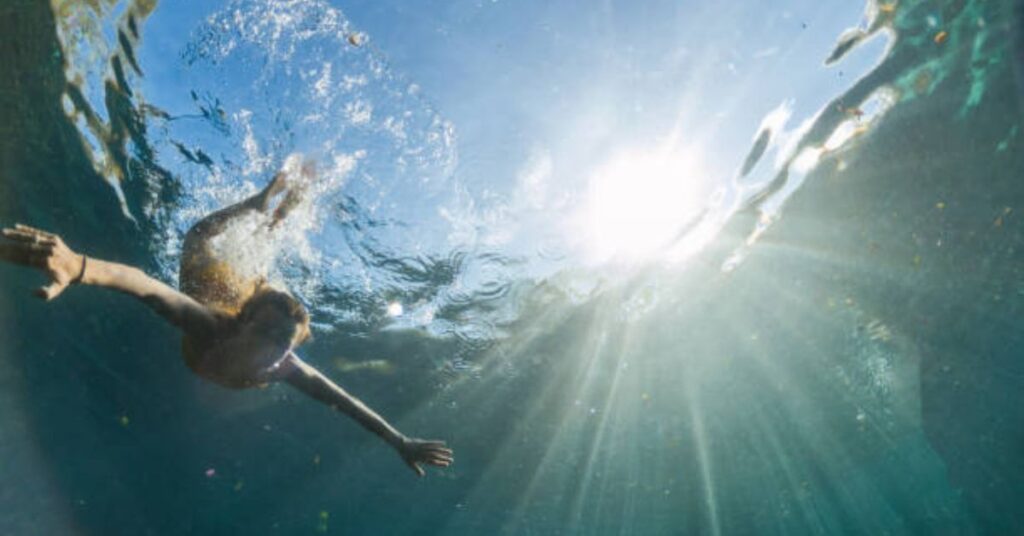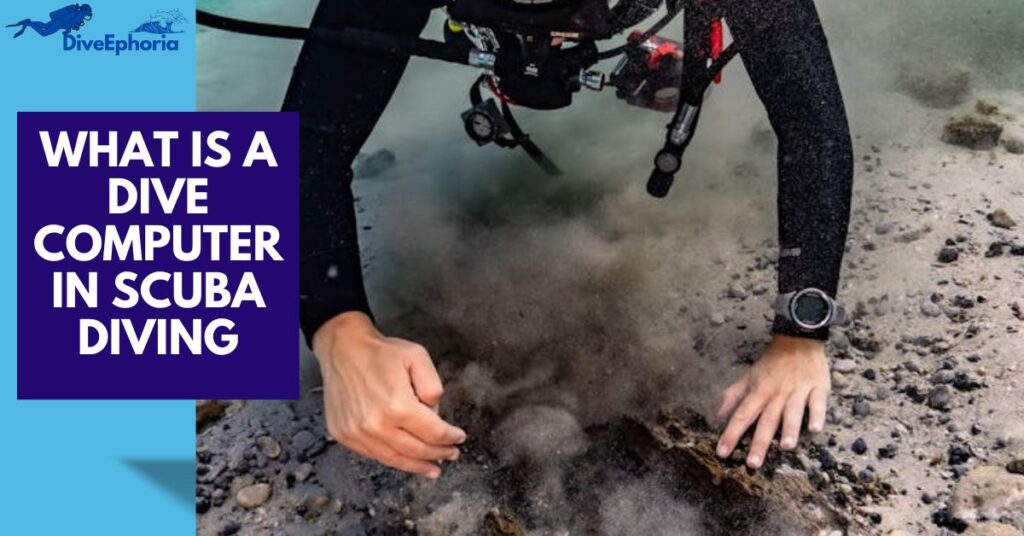
Table of Contents
Introduction
Every scuba diver, from beginners to seasoned professionals, understands the importance of air consumption. Running out of air too quickly can shorten dive times, increase stress, and limit the overall experience. If you find yourself surfacing earlier than your dive buddies, you’re not alone—many divers struggle with inefficient air use.
In this guide, we’ll explore the best ways to improve air consumption while diving, helping you extend your dive time, conserve energy, and enjoy the underwater world to the fullest. We’ll cover practical breathing techniques, physical conditioning, and expert tips to make each breath underwater more efficient.
Why Is Air Consumption Important in Scuba Diving?

Mastering air consumption is one of the most crucial skills for any scuba diver, whether you’re a beginner or an experienced underwater explorer. Efficient air use directly impacts your bottom time, dive safety, and overall enjoyment of the dive. Understanding the importance of air consumption in scuba diving can help you develop habits that make each dive longer, safer, and more relaxed.
When you breathe more efficiently underwater, you conserve the air in your tank, which allows for longer dive durations without needing to surface early. Poor air management often results in cutting dives short, separating from the group, or feeling rushed—all of which can reduce the quality of your diving experience.
Here are several key reasons why optimizing air consumption while scuba diving is essential:
1. Maximizing Bottom Time
One of the biggest advantages of improving your air consumption is that it allows you to stay underwater longer. Whether you’re exploring a colorful reef, investigating a shipwreck, or observing marine life, having extra minutes underwater enhances your experience and lets you make the most out of every dive.
2. Enhancing Safety
Efficient air management is a critical safety factor. Divers who burn through their air too quickly are at a higher risk of stress, rapid ascents, and potential accidents. Managing your air supply responsibly ensures you have enough reserve to handle unexpected situations, such as strong currents, navigational challenges, or assisting a buddy in need.
3. Improving Buoyancy Control
Proper breathing plays a direct role in buoyancy control—one of the core skills in scuba diving. Controlled, slow breathing allows you to fine-tune your buoyancy without excessive use of your BCD (buoyancy control device). This leads to a smoother, more energy-efficient dive where you can glide effortlessly instead of constantly adjusting your position.
4. Reducing Physical and Mental Stress
Rapid or shallow breathing can cause a build-up of carbon dioxide, leading to feelings of anxiety, disorientation, or even panic underwater. Adopting effective scuba diving breathing techniques helps maintain a calm mind and relaxed body, significantly reducing stress and making dives safer and more enjoyable.
5. Conserving Energy and Reducing Fatigue
Good air consumption habits mean your body works less hard to move and breathe underwater. This minimizes fatigue, allows you to explore more, and helps you surface feeling energized instead of exhausted.
1. Master Proper Breathing Techniques

When it comes to improving air consumption while scuba diving, mastering proper breathing techniques is absolutely essential. Breathing efficiently not only conserves your air supply but also improves buoyancy, reduces anxiety, and enhances overall dive safety. Whether you’re a new diver or an experienced one looking to refine your skills, focusing on how you breathe underwater can dramatically extend your bottom time.
Here’s how you can master breathing techniques for better air efficiency:
1.1 Breathe Slowly and Deeply
One of the most important scuba diving breathing techniques is adopting a slow, deep breathing pattern. Shallow, quick breaths are inefficient, cause faster air depletion, and can lead to carbon dioxide buildup, making you feel breathless and anxious.
Tip: Focus on breathing deeply from your diaphragm rather than shallow chest breathing. Inhale slowly, filling your lungs completely, and exhale fully and smoothly. This maximizes oxygen exchange and keeps your breathing rate calm and steady.
1.2 Use the “2:1” Breathing Ratio
Another highly effective method to improve air consumption while diving is the “2:1” breathing ratio. This technique involves exhaling for twice as long as you inhale, which helps you stay relaxed and prevents rapid air loss.
Example: Inhale for 4 seconds, then exhale slowly over 8 seconds.
Extending your exhalation promotes relaxation, improves buoyancy control, and minimizes excessive effort, all of which contribute to conserving your tank air.
1.3 Practice “Bubble Breathing”
Visualizing your exhalation can make a surprising difference. Bubble breathing is a mental technique where you imagine a steady, slow stream of bubbles escaping from your regulator as you breathe out. It encourages you to focus on smooth, controlled exhalations rather than rushed, panicked breaths.
Practicing bubble breathing during shallow dives or pool sessions can train your body and mind to maintain composure and efficiency during deeper or more challenging dives.
1.4 Pause Briefly After Each Inhale
After inhaling deeply, add a short natural pause before beginning your exhale. This slight pause (without holding your breath, which is dangerous in diving) allows for better gas exchange in your lungs and makes your breathing cycle more controlled.
Caution: Never hold your breath deliberately while scuba diving, as it can lead to serious injury like lung over-expansion.
2. Improve Buoyancy Control

Mastering buoyancy control is one of the most critical skills for any scuba diver aiming to improve air consumption underwater. Poor buoyancy forces you to constantly adjust your position, which wastes energy and burns through your air supply much faster. In contrast, achieving neutral buoyancy allows you to glide effortlessly, conserve energy, and dramatically extend your dive time.
Let’s break down exactly how improving buoyancy control can help you use your air more efficiently:
2.1 Achieve Neutral Buoyancy
Neutral buoyancy means you are perfectly balanced in the water — not floating up or sinking down. When you are neutrally buoyant, you expend minimal effort to stay at your desired depth, reducing the physical exertion that leads to higher air consumption.
Action Step:
Before descending, perform a buoyancy check at the surface. With a normal breath held in and a properly weighted setup, you should float at eye level in the water. When you exhale, you should slowly begin to sink. This indicates you’re carrying the correct amount of weight.
Benefits of Neutral Buoyancy:
- Reduces the need for constant finning
- Minimizes contact with fragile marine environments
- Lowers heart rate and stress levels, conserving air
2.2 Master Breathing for Buoyancy Adjustments
Once underwater, fine-tune your buoyancy using your lungs rather than your BCD (Buoyancy Control Device) alone. Slight inhalations make you rise, and slow exhalations help you descend. This skill allows you to move smoothly without wasting air on frequent BCD adjustments.
Pro Tip: Use your BCD for major buoyancy changes (like after descending), but rely on breath control for minor adjustments during your dive.
2.3 Maintain a Streamlined Body Position
Swimming in an upright or awkward position creates unnecessary drag and resistance, forcing you to work harder and breathe faster. A streamlined, horizontal body position improves hydrodynamics, allowing you to move efficiently through the water with less effort.
How to Stay Streamlined:
- Tuck your arms close to your body
- Keep your legs straight and slightly bent at the knees
- Align your head, torso, and fins in one smooth line
Tip: Imagine you’re a torpedo gliding forward — the less surface area you present to the water, the easier it will be to move and the less air you’ll consume.
2.4 Practice Efficient Finning Techniques
Inefficient or frantic finning increases your workload and skyrockets air consumption. Instead, focus on controlled, smooth kicks. Techniques like the frog kick or slow, wide flutter kicks are excellent for conserving energy.
Quick Tip: Watch how experienced divers kick — small, deliberate movements go a long way toward improving your efficiency and reducing air usage.
3. Enhance Your Physical Fitness

When it comes to improving air consumption while diving, enhancing your physical fitness plays a critical role. A fitter, healthier body uses oxygen more efficiently, meaning you’ll breathe slower and require less air during each dive. Physical conditioning not only extends your bottom time but also reduces fatigue, improves stress management, and boosts your overall diving performance.
Let’s dive into how building your fitness can help you conserve air underwater:
3.1 Strengthen Your Cardiovascular Health
Cardiovascular fitness directly impacts how efficiently your body uses oxygen. A strong heart and lungs allow you to circulate oxygen more effectively, resulting in slower, deeper breathing patterns — exactly what you want while scuba diving.
Recommended Activities:
- Swimming: Builds endurance and mimics diving movements.
- Running or Jogging: Improves lung capacity and heart strength.
- Cycling: Enhances stamina and leg strength without stressing the joints.
Pro Tip: Aim for at least 30 minutes of cardio, three to five times a week, to significantly improve your aerobic capacity.
3.2 Build Core and Muscle Strength
Diving may seem effortless, but maintaining stability underwater requires strong core muscles. Strengthening your abs, back, and glutes improves posture and balance, making it easier to maintain a streamlined position — which, in turn, reduces air consumption.
Effective Strength Exercises:
- Planks and side planks
- Pilates or yoga for core engagement
- Weighted squats and lunges for leg endurance
A stronger body moves more efficiently underwater, burns less oxygen, and manages buoyancy better.
3.3 Practice Breath-Holding Techniques
Training your body to handle higher levels of carbon dioxide (CO2) can greatly improve your air consumption during dives. Freediving breath-hold techniques can teach you how to tolerate CO2 buildup and make better use of your available oxygen.
Breath-Hold Training Ideas:
- Static Apnea Training: Hold your breath while floating in a pool or lying down, gradually increasing the time.
- CO2 Tolerance Tables: Structured breath-hold exercises designed to build CO2 resistance.
Caution: Always practice breath-hold training with a buddy or professional supervision, especially in water.
3.4 Maintain Flexibility and Mobility
Increased flexibility makes it easier to maneuver underwater without unnecessary effort or strain. Yoga and stretching exercises improve joint mobility, helping you maintain a more streamlined posture and reducing drag.
Flexibility Benefits for Divers:
- Easier gear management
- Better finning techniques
- Reduced muscle fatigue
4. Reduce Unnecessary Movements
One of the most effective ways to improve air consumption while diving is to reduce unnecessary movements. Every extra kick, hand wave, or sudden shift in position burns more energy — and with it, precious air. By moving efficiently and deliberately, you not only conserve energy but also lower your heart rate, leading to slower breathing and longer bottom times.
Let’s explore how reducing unnecessary movements can help you breathe better underwater:
4.1 Move Slowly and Deliberately
Fast, jerky, or erratic movements increase your body’s oxygen demand. The faster and more forcefully you move, the more air your body needs to keep up with the exertion.
Tips for Slow, Efficient Movement:
- Glide rather than swim rapidly from point to point.
- Pause and observe your surroundings instead of constantly swimming.
- Make smooth, controlled adjustments to your depth or direction.
Remember: In diving, slow is smooth, and smooth is efficient.
4.2 Master Efficient Kicking Techniques
Your legs are among the largest muscle groups in your body, and inefficient kicking burns a lot of energy. Instead of big, fast kicks, focus on small, slow, and controlled fin strokes.
Best Kicking Techniques for Air Conservation:
- Frog Kick: Mimics the swimming style of a frog, allowing for better control and reduced water disturbance.
- Modified Flutter Kick: A slow, narrow flutter movement that minimizes drag and effort.
- Helicopter Turn: Use minimal fin movement to rotate your body in place without expending much energy.
Efficient kicking not only saves air but also improves your overall diving technique and positioning.
4.3 Keep Your Hands Still
Using your hands to swim or balance underwater is unnecessary and inefficient. Your fins should provide all the propulsion you need. Constant hand movements increase drag and waste energy, accelerating air consumption.
Tip: Cross your arms lightly over your chest or clasp your hands together to prevent unnecessary hand motion.
4.4 Minimize Depth Changes
Constantly moving up and down through the water column requires frequent buoyancy adjustments, which consume both energy and air. Aim to maintain a consistent depth whenever possible.
Action Step: Fine-tune your buoyancy early in the dive to minimize the need for inflating and deflating your BCD.
4.5 Stay Streamlined
The more streamlined your body and gear setup, the less resistance you create when moving through the water. Reducing drag makes movement easier and less energy-intensive.
Streamlining Tips:
- Secure hoses and accessories close to your body.
- Keep your body horizontal and aligned with your direction of travel.
- Choose low-profile gear to minimize water resistance.
5. Optimize Your Gear for Air Efficiency
Choosing and maintaining the right scuba gear plays a crucial role in improving your air consumption while diving. Even if you master breathing techniques and buoyancy control, inefficient equipment can work against you, causing you to use more air than necessary. Optimizing your gear setup ensures you move effortlessly, breathe comfortably, and stay longer underwater.
Here’s how you can optimize your scuba diving gear for maximum air efficiency:
5.1 Use a High-Quality, Well-Maintained Regulator
Your regulator is your life support underwater — it needs to deliver air smoothly and effortlessly. If your regulator is outdated, poorly maintained, or of lower quality, it can increase the work of breathing, causing you to breathe harder and consume more air.
Tips for Regulator Optimization:
- Invest in a balanced, environmentally-sealed regulator for consistent airflow at different depths.
- Get your regulator professionally serviced at least once a year.
- Choose a regulator known for low breathing resistance to reduce air effort.
Bonus: Lightweight second stages can also help reduce jaw fatigue, letting you breathe more naturally.
5.2 Reduce Excess Weight and Drag
Carrying too much weight or unnecessary gear can create drag and make you expend more energy during a dive, which spikes air consumption.
Streamlining Your Dive Setup:
- Trim down your gear to essentials only.
- Secure dangling hoses and accessories to your BCD.
- Use a low-profile BCD and compact fins to glide more efficiently through the water.
Streamlining your body and gear setup cuts down on drag, requiring less effort to move — and less air to fuel that movement.
5.3 Check for and Fix Air Leaks
Even minor air leaks from your hoses, O-rings, or inflator mechanisms can slowly drain your tank during a dive without you noticing, cutting your dive short.
How to Prevent Air Leaks:
- Conduct thorough pre-dive checks to listen and feel for leaks.
- Replace worn O-rings regularly.
- Inspect LP (Low-Pressure) and HP (High-Pressure) hoses for cracks, bulges, or wear.
A simple leak can waste a surprising amount of air — a quick fix saves dive time and enhances safety.
5.4 Choose the Right Wetsuit or Drysuit
Thermal comfort is directly tied to air consumption. If you’re cold underwater, your body burns more energy trying to maintain warmth, causing you to breathe faster and use up more air.
Choosing Appropriate Exposure Protection:
- Wear a properly fitted wetsuit or drysuit suitable for the water temperature.
- Layer appropriately with thermal undergarments if diving in colder environments.
- Avoid suits that are too tight (restricting breathing) or too loose (causing drag).
Staying warm and comfortable allows for calmer, slower breathing — one of the best ways to conserve air.
5.5 Upgrade to a Dive Computer
Modern dive computers help divers maintain ideal depth profiles, avoid rapid ascents, and plan more efficient dives. Some models even track Surface Air Consumption (SAC) rates and air-integrated computers monitor your tank pressure in real-time.
Benefits of Using a Dive Computer:
- Precise depth control to avoid unnecessary buoyancy adjustments.
- Real-time air tracking to manage breathing rates consciously.
- Better dive planning for energy-efficient profiles.
6. Stay Relaxed and Minimize Stress
Staying relaxed underwater is one of the most effective ways to improve air consumption while diving. Stress, anxiety, and panic cause your heart rate and breathing rate to spike, leading to rapid air depletion. Maintaining a calm, composed mindset not only makes diving more enjoyable but also conserves precious air and enhances overall safety.
Here’s how to stay relaxed and stress-free during your dives:
6.1 Practice Mindful Breathing Techniques
Mindful, controlled breathing helps you stay calm and focused underwater. By consciously slowing your breath and maintaining a steady rhythm, you can keep your body relaxed and reduce air consumption.
Quick Tips for Mindful Breathing:
- Inhale deeply through your nose or regulator.
- Exhale slowly, allowing all the air to leave your lungs.
- If you feel your heart racing, pause, float neutrally, and take a few deep, controlled breaths.
Think of your breathing as a metronome that sets the pace for your dive — slow and steady wins the air-efficiency race.
6.2 Stay Within Your Comfort Zone
Diving within your training limits and experience level significantly reduces stress. If you push yourself into uncomfortable situations — like strong currents, deep dives, or unfamiliar environments — you’re more likely to panic and breathe heavily.
How to Stay Comfortable:
- Choose dive sites appropriate for your skill level.
- Practice new skills in controlled environments (like a pool or shallow dives) before attempting them in open water.
- Gradually progress to more challenging dives as you gain experience and confidence.
Remember, there’s no shame in sitting out a dive that feels beyond your ability — smart divers know their limits.
6.3 Master Pre-Dive Preparation
A rushed or disorganized start to a dive can set a stressful tone before you even hit the water. Proper preparation can significantly lower pre-dive anxiety.
Pre-Dive Preparation Checklist:
- Double-check your gear the night before.
- Arrive early to avoid rushing.
- Review the dive plan carefully.
- Practice visualization — mentally walk through your dive to build confidence.
When everything is in order, you can enter the water with a clear head and relaxed body.
6.4 Communicate Clearly with Your Dive Buddy
Uncertainty and miscommunication can spike anxiety levels underwater. Establish clear communication signals with your buddy before diving, and agree on basic protocols for separation, air checks, and ascent procedures.
Good Buddy Practices:
- Perform thorough buddy checks (BWRAF or pre-dive safety check).
- Stay close and maintain visual contact throughout the dive.
- Signal any concerns early rather than waiting until stress escalates.
Knowing your buddy has your back (and vice versa) is incredibly calming and reassuring.
6.5 Embrace a Positive Mindset
Lastly, maintaining a positive, flexible attitude can help you manage unexpected challenges underwater. Conditions might change, equipment might malfunction, or you might feel nervous — and that’s okay.
Positive Mindset Strategies:
- Focus on problem-solving rather than panicking.
- Remember your training and take one step at a time.
- Practice self-talk: Remind yourself that you are capable, trained, and prepared.
7. Dive More Frequently
One of the most natural and effective ways to improve air consumption while diving is simply by diving more often. Like any skill, scuba diving becomes easier, more intuitive, and more efficient with consistent practice. The more time you spend underwater, the better you understand your body’s oxygen needs, refine your buoyancy control, and manage your breathing patterns — all critical factors in reducing air use.
Here’s why frequent diving plays a key role in better air consumption and overall dive performance:
7.1 Build Comfort and Confidence Underwater
Frequent diving helps eliminate the small stresses that can cause unnecessary air wastage. Whether it’s fiddling with equipment, adjusting buoyancy, or dealing with slight discomfort, practice makes everything smoother and more automatic.
Benefits of Comfort Building:
- Lower heart rate and breathing rate.
- Less wasted energy on adjusting gear or body position.
- More mental focus on enjoying the dive rather than worrying.
The more relaxed and confident you feel, the less air you’ll consume.
7.2 Develop Muscle Memory
With regular dives, movements like adjusting your buoyancy, clearing your mask, or swimming efficiently become second nature. These automatic skills reduce the physical and mental effort required during a dive, conserving both energy and air.
Examples of Skills That Benefit from Muscle Memory:
- Achieving neutral buoyancy with minor fin adjustments instead of inflating/deflating your BCD constantly.
- Streamlining your body position automatically.
- Reacting calmly to minor issues like a leaking mask or current changes.
Over time, your body learns to move efficiently underwater, leading to better air management.
7.3 Fine-Tune Your Breathing Techniques
Even if you practice breathing techniques on land, nothing replaces the real-world experience of controlling your breath underwater. Frequent diving allows you to refine slow, deep breathing habits under varying conditions like cold water, currents, or different depths.
Practice Makes Perfect:
- Adjust your breathing to match different dive environments.
- Learn how different water temperatures and suit thicknesses affect your breathing and buoyancy.
- Adapt quickly to unexpected scenarios without over-breathing.
Each dive adds to your experience bank, making your breathing more efficient naturally.
7.4 Gain Better Environmental Awareness
When you dive often, you become better at reading and responding to underwater environments. Recognizing conditions like strong currents, surge, or thermoclines allows you to adapt your dive plan and movements, conserving energy and air.
Environmental Skills That Save Air:
- Finding and using natural shelter to avoid swimming against currents.
- Following the reef contour for easier swimming paths.
- Adjusting your buoyancy early when encountering changes in water temperature or salinity.
Efficient environmental adaptation means fewer unnecessary movements and lower air consumption.
7.5 Turn Diving into a Habit, Not a Special Occasion
If you dive only occasionally, you may feel rusty each time, leading to anxious breathing, inefficient movements, and higher air use. Regular diving keeps your skills sharp and your body conditioned for the demands of underwater exploration.
Pro Tip:
Even if you can’t get to the ocean often, diving in local lakes, quarries, or taking refresher courses can maintain your muscle memory and breathing control.
Conclusion
Improving air consumption while diving is a skill that enhances dive time, safety, and enjoyment. By mastering proper breathing techniques, refining buoyancy, maintaining fitness, and using the right gear, divers can significantly reduce air use and maximize underwater experiences.
Ready to take your diving skills to the next level? Explore our recommended diving gear and expert guides to make every dive more efficient and enjoyable!
FAQs
How can I stop using so much air when diving?
Focus on controlled breathing, improving buoyancy, and reducing unnecessary movement to lower air consumption.
Does being overweight affect air consumption?
Yes, carrying excess weight can increase exertion and lead to faster air depletion. Improving fitness can help optimize air use.
How does proper weighting help with air consumption?
Being properly weighted allows you to maintain neutral buoyancy with less effort, conserving energy and air.
What is the best breathing technique for scuba diving?
Slow, deep diaphragm breathing with a controlled exhale (2:1 ratio) is the most efficient method.
How do I train my lungs to use air more efficiently?
Practicing apnea exercises, cardiovascular fitness, and relaxation techniques can help improve lung efficiency.
Does diving in cold water affect air consumption?
Yes, cold water can cause the body to work harder to maintain warmth, leading to increased air consumption. Wearing proper thermal protection can help.
Can a high-quality regulator improve air consumption?
Yes, a well-maintained and high-performance regulator provides smoother breathing, reducing effort and conserving air.


